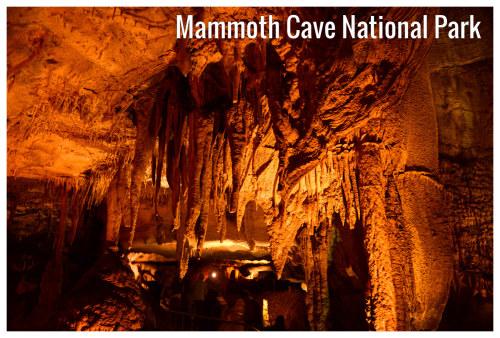Contents
- The climate of Mammoth Cave National Park
- The best time to visit Mammoth Cave National Park
- The worst time to visit Mammoth Cave National Park
- Spring weather in Mammoth Cave National Park
- Summer weather in Mammoth Cave National Park
- Autumn weather in Mammoth Cave National Park
- Winter weather in Mammoth Cave National Park
- Weather in January
- Weather in February
- Weather in March
- Weather in April
- Weather in May
- Weather in June
- Weather in July
- Weather in August
- Weather in September
- Weather in October
- Weather in November
- Weather in December
- Frequently asked questions
- Average temperature
- Average rainfall
- Average rainfall days
- Average daylight
- Average sunshine
- Average UV index

Climate and monthly weather forecast
The climate of Mammoth Cave National Park
Beginning with temperatures, there's a substantial shift from the coldest to the warmest month with average temperatures ranging from 23°F (-5°C) to 88°F (31.1°C). The hottest months are generally July and August, with an average high of 88°F (31.1°C) and 86°F (30°C) respectively. Conversely, the coldest months are January and February where temperatures plummet to a low of 23°F (-5°C) and 25°F (-3.9°C) respectively.
Regarding precipitation, The National Park receives a significant amount of rainfall throughout the year with the highest recorded in May at 5" (127mm). Following closely is July with rainfall measurements up to 4.8" (122mm). The months receiving the least rainfall are September and October with amounts measuring up to 3.7 and 3" (76mm) respectively.
With regards to sunshine, the park is bathed with an ample amount of sunlight throughout the year. June presents the highest amount with daily sunshine hours reaching up to 10 hours. On the other hand, the park receives the least amount of sunshine in December and January with sunlight averaging around 4 hours a day.
The best time to visit Mammoth Cave National Park
The worst time to visit Mammoth Cave National Park
Spring weather in Mammoth Cave National Park
Summer weather in Mammoth Cave National Park
Autumn weather in Mammoth Cave National Park
Winter weather in Mammoth Cave National Park
Weather in January
Weather in February
Weather in March
Weather in April
Weather in May
Weather in June
Weather in July
Weather in August
Weather in September
Weather in October
Weather in November
Weather in December
Published by: Weather U.S. | About Us
Data Sources | Weather Forecasting & Climate
Frequently asked questions
What time of the year is the coldest?
How many days does it rain?
What are the months with the least sunshine?
What is the month with the lowest UV index in Mammoth Cave National Park?
When is Daylight Saving Time (DST)?
What is the rainiest month?
When are the longest days in Mammoth Cave National Park?
What month has the most sunshine?
What are the months with the highest UV index?
What part of the year is the hottest?
What is the driest month?
What is the month with the shortest days?

Average temperature
Mammoth Cave National Park, KY
The warmest month (with the highest average high temperature) is July (88°F).
The month with the lowest average high temperature is January (41°F).
The month with the highest average low temperature is July (66°F).
The coldest month (with the lowest average low temperature) is January (23°F).

Average rainfall
Mammoth Cave National Park, KY
The wettest month (with the highest rainfall) is May (5").
The driest month (with the least rainfall) is October (3").

Average rainfall days
Mammoth Cave National Park, KY
- Average rainfall days in January:
11 days - Average rainfall days in February:
11 days - Average rainfall days in March:
13 days - Average rainfall days in April:
11 days - Average rainfall days in May:
12 days - Average rainfall days in June:
10 days
- Average rainfall days in July:
11 days - Average rainfall days in August:
9 days - Average rainfall days in September:
8 days - Average rainfall days in October:
8 days - Average rainfall days in November:
10 days - Average rainfall days in December:
12 days
The month with the highest number of rainy days is March (13 days).
The months with the least rainy days are September and October (8 days).

Average daylight / Average sunshine
Mammoth Cave National Park, KY
- Average daylight in January:
10h and 0min - Average daylight in February:
10h and 5min - Average daylight in March:
12h and 0min - Average daylight in April:
13h and 1min - Average daylight in May:
14h and 1min - Average daylight in June:
14h and 4min
- Average daylight in July:
14h and 2min - Average daylight in August:
13h and 3min - Average daylight in September:
12h and 2min - Average daylight in October:
11h and 1min - Average daylight in November:
10h and 1min - Average daylight in December:
9h and 4min
The month with the longest days is June (Average daylight: 14h and 42min).
The month with the shortest days is December (Average daylight: 9h and 42min).
The month with the most sunshine is June (Average sunshine: 10h).
The months with the least sunshine are January and December (Average sunshine: 4h).

Average UV index
Mammoth Cave National Park, KY
The months with the highest UV index are June and July (UV index 10).
The months with the lowest UV index are January and December (UV index 2).